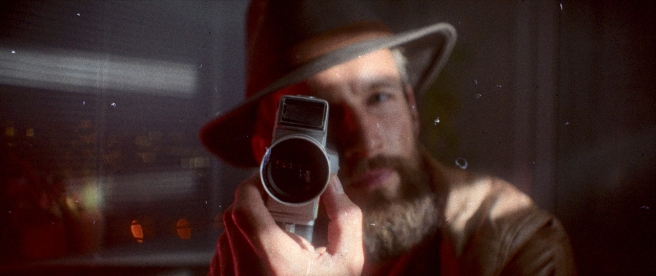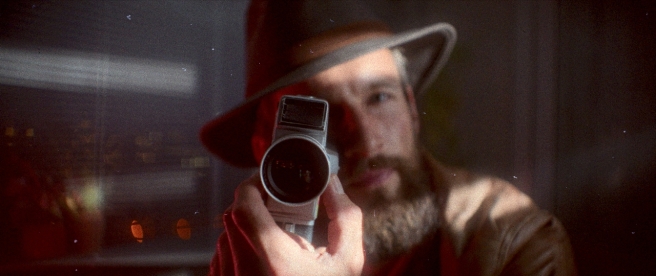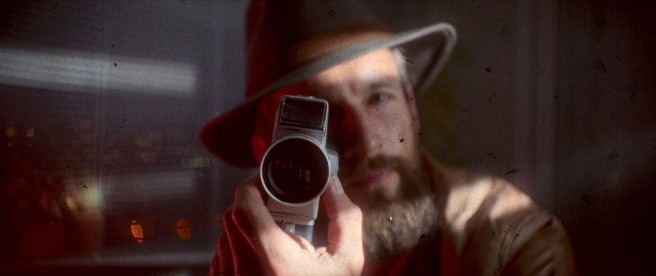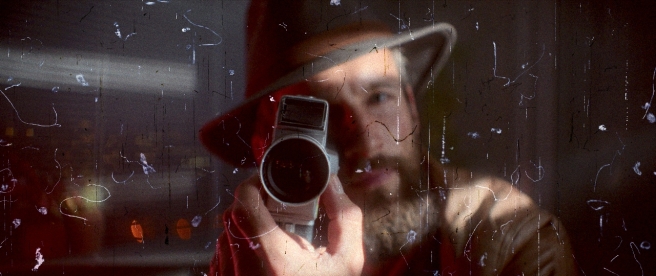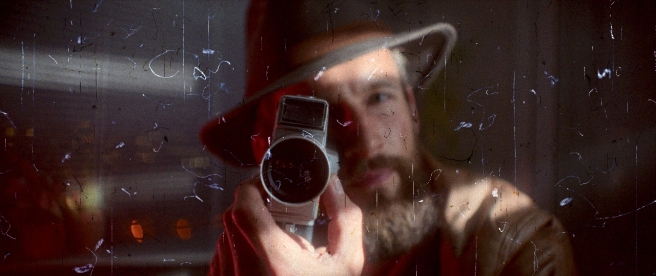
When shooting on film and then processing, storing, duplicating and displaying it, all sorts of defects – dust, hair, scratches, stains, emulsion irregularities and more extensive damage – inevitably appear in the image. A small amount of natural artifacts can be found even on a fresh, properly processed film.
Defects increase at every stage of film production. Normally, the most noticeable artifacts are removed during postproduction stage, but it is impossible and unnecessary to get rid of them completely. Natural ‘dirt’ enhances the impression and introduces a sense of time. Therefore, when working with digital source, such artifacts are often added artificially as part of stylisation.
The new Film Damage tool combines thousands of unique samples from real film with special generation and transformation algorithms to achieve a lifelike result.
Film Damage consists of several modules, each responsible for a different type of artifact.

DUST
Dust on film always exists, but it may look different at different production stages and with different photographic materials. You can adjust the settings as you like:
Dust Amount
The total number of dust particles that can be present within the frame at the same time.
Scale
The parameter sets the scale of dust, i.e., the single coefficient of magnification for all particles.
In real life, this parameter is determined by the film format, because it determines the size of artifacts relative to the physical area of the frame. For example, on Super 8 film all defects look much larger than on 35 mm, while on 65 mm film the dust may be very small relative to the frame size, and almost unnoticeable.
Size Balance
The physical size of the particles varies over a wide range, and both very small and larger dust specks may appear in the same frame.
The Size Balance slider adjusts the ratio between artifacts of different sizes.
At the minimum value only the smallest particles are added, at the maximum – the largest ones, and in the middle position – about the same amount of dust of different sizes.
White-Black
Particles that deposit on the negative emulsion during the shooting process leave unexposed areas underneath, light on the negative and dark after it is reversed (by optical printing or scanning). Dust on the positive material also shows up as dark artifacts.
At the positive printing stage, the particles also get on the film and cover areas of the emulsion from the exposure to light. After processing, such dust appears white. A similar effect is observed when scanning the negative directly, with digital reversal.
Thus, a positive image always contains both light and dark artifacts, in a proportion that depends on the shooting conditions, the number of intermediate stages and the accuracy of film processing.
The White-Black parameter adjusts the quantitative ratio between light and dark artifacts. In the leftmost position only light particles will appear, in the rightmost position – the dark ones, and in the middle position both light and dark particles will appear equally.
Dust Enabled
The Dust Enabled checkbox turns dust on or off completely.
HAIRS
The hairs and fibers show up on film in the same way as dust and have the same origin, although usually they are evident in smaller quantities.
Therefore, the Hairs module has similar parameters.
Hairs Amount
The total number of hairs that can be present within the frame at the same time.
Scale
The parameter sets the scale of hairs, i.e., the single coefficient of magnification for all particles.
Size Balance
The Size Balance slider adjusts the ratio between hairs of different sizes.
At the minimum value only the smallest hairs are added, at the maximum – the largest ones, and in the middle position – about the same amount of hairs of different sizes.
White-Black
The hairs appear on the emulsion according to the same principles as the dust, and the White-Black parameter similarly adjusts the quantitative ratio between light and dark artifacts.
Hairs Enabled
The Hairs Enabled checkbox turns hairs on or off completely.
SCRATCHES
Scratches on the emulsion and the film base are the most recognizable film artifacts. However, in professional filmmaking it appears insignificantly and is more typical of amateur cinema, when the frame area is smaller, and a single film copy could survive sloppy handling and dozens of screenings, each adding new damage. The scratches are especially noticeable on old archival copies.
Scratches adjustment is similar to Dust and Hairs.
Scratches Amount
The total number of scratches that can be present within the frame at the same time.
Scale
The parameter sets the magnification of all scratches relative to the frame size.
Size Balance
Size Balance adjusts the ratio between large and small scratches.
White-Black
Depending on which stage of the film production the scratches appeared, they may be dark or light. The ratio between them can be adjusted with the White-Black parameter.
Scratches Enabled
The Scratches Enabled checkbox turns scratches on or off completely.
GLOBAL SETTINGS
Total Amount
You can use the Total Amount slider to decrease or increase the total amount of all artifacts within the frame, with no need to reconfigure each type individually.
Global Period
The defect areas on film are irregular along its length. This is due to natural factors and the mechanisms used to transport the film.
The Global Period parameter controls how often artifacts appear in the frames. The smaller the value, the more evenly the defects are distributed along the length of the roll.
When Global Period = 1, the amount of dirt between neighboring frames will be almost the same. When Period is increased, the areas with the maximum and minimum amount of artifacts will be more extended. At the same time, the number of defects within each period also varies randomly, for greater realism.
Global Opacity
Global Opacity allows you to adjust the total transparency of the effect, to make it more or less noticeable. This parameter doesn’t affect the number of artifacts, but only their visual density.
Global Chromaticity
Dirt particles affect the light flow, and their transparency, thickness, distance from the film surface, depth of damage and other factors determine the affected emulsion layers and their exposure.
When transparency is reduced, light artifacts visually take on a bluish hue, while dark artifacts, on the contrary, appear warmer.
The Global Chromaticity parameter adjusts the overall saturation. When it is set to minimum, artifacts become pure black and white, regardless of their transparency.
Film Damage Profiles
For your convenience, we have added factory profiles to the Film Damage tool with the parameters matched to emulate the standard film formats – 8 mm, 16 mm, 35 mm, and 65 mm.
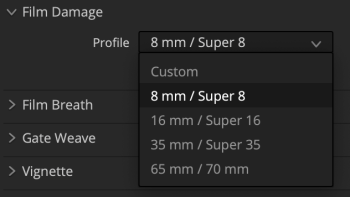
In this video you can see tool profiles in action:
Authors:
© Pavel Kosenko
© Dmitry Novak
© Denis Svinarchuk


